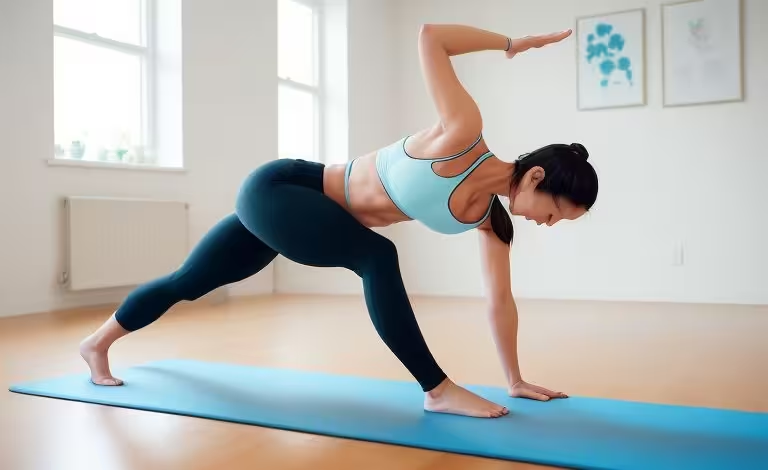
5 Best Indoor Exercises to Beat depression
Feeling down and stuck indoors? Here are five Indoor Exercises to help you fight depression and feel better. These easy activities can lift your mood and improve your overall well-being.
Yoga
Yoga is a fantastic indoor exercise for depression. It combines poses, breathing exercises, and meditation to reduce stress and boost brain chemicals that make you feel happy. Simple poses like child’s pose, downward dog, and cat-cow stretch are a good start. If you’re new to yoga, try guided videos or virtual classes to help you along the way. By practicing yoga regularly, you can lower stress hormones and increase serotonin, improving your mental health and mood.
Yoga also helps with mindfulness, allowing you to focus on the present moment. This can be especially helpful when dealing with negative thoughts. The combination of physical activity and mental focus makes yoga an excellent choice for anyone looking to combat depression.
Dancing
Dancing is a fun and effective indoor exercise for depression. It lifts your spirits and gets your heart pumping, releasing endorphins that improve your mood. Dancing also encourages social interaction, which can help reduce feelings of loneliness and isolation. Simply play your favorite music and dance around your room. You can also join online dance workout classes if you prefer a more structured routine.
Dancing has many benefits for your mental health. It’s a great way to express yourself and release emotions. The rhythm and movement can be incredibly therapeutic, allowing you to shed your emotional barriers and feel more connected to yourself and others. Plus, it’s a fantastic cardiovascular workout that keeps you physically healthy.
Strength Training
Strength training is another excellent indoor exercise for depression. It boosts your confidence and reduces anxiety and depression symptoms. Exercises like lifting weights, squats, and push-ups can help you feel stronger and more in control. Start with dumbbells, bodyweight exercises, and resistance bands. Use fitness apps or online programs to guide you through a beginner’s strength training routine.
Strength training has numerous mental health benefits. It helps reduce anxiety by giving you a sense of accomplishment and progress. As you build strength, you also build self-esteem, which can help combat depression. Regular strength training can lead to better sleep, increased energy levels, and a more positive outlook on life.
Pilates
Pilates is an indoor exercise that promotes a strong mind-body connection, improves mental clarity, and reduces stress. It involves gentle movements that focus on flexibility, mindful movement, and core strength. Pilates can lower depression symptoms and promote overall health. Try using a fitness app or online Pilates classes, starting with exercises like leg circles, roll-ups, and the hundred.
Pilates encourages mindful movement, which helps you stay present and focused. This can be very beneficial when dealing with depression, as it allows you to take a break from negative thoughts. The physical benefits of Pilates, such as improved posture and reduced discomfort, also contribute to better mental health. By practicing Pilates regularly, you can feel more balanced and in control.
Indoor Walking or Running
Indoor walking or running is a simple yet effective way to improve your mental health and combat depression. You can walk or run in place, around your home, or use a treadmill if you have one. These activities release endorphins, which help lift your mood and reduce depression symptoms.
Walking or running indoors is accessible to everyone and requires no special equipment. It’s a great way to stay active, even when you can’t go outside. These exercises improve cardiovascular health, increase energy levels, and help you maintain a healthy weight. Regular indoor walking or running can significantly improve your mental health and overall well-being.
Tips for Getting Started with Indoor Exercises
- Set a Routine: Establish a regular exercise routine to stay consistent. Aim for at least 30 minutes of exercise most days of the week.
- Create a Comfortable Space: Designate a specific area in your home for exercise. Make sure it’s comfortable and free of distractions.
- Stay Hydrated: Drink plenty of water before, during, and after your workouts to stay hydrated.
- Listen to Your Body: Pay attention to how your body feels during exercise. Start slowly and gradually increase the intensity.
- Seek Support: Join online exercise communities or classes to stay motivated and connected with others.
depression and Mental Health: What You Should Know
depression is a mental health condition that affects your mood and behavior. Poor mental health can lead to depression, which then worsens your overall well-being. To maintain good mental health, include therapy and healthy habits that manage or prevent depression.
Engaging in regular indoor exercise is a powerful way to improve your mental health. It helps reduce stress, boost mood, and increase energy levels. By incorporating Indoor Exercises into your daily routine, you can better manage depression and enhance your overall quality of life.
Final Thoughts
Indoor Exercises are a simple yet powerful way to fight depression and improve your mental health. Whether you choose yoga, dancing, strength training, Pilates, or indoor walking, staying active can help you feel better, even when you’re stuck inside. Keep moving and take care of your mental health!
By making these Indoor Exercises a part of your routine, you can create a healthier, happier lifestyle. Remember, the key to combating depression is consistency and self-care. So, put on your workout gear, find a comfortable space, and start moving. Your mind and body will thank you!



